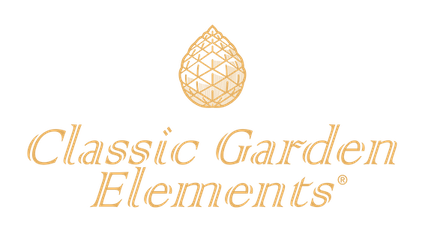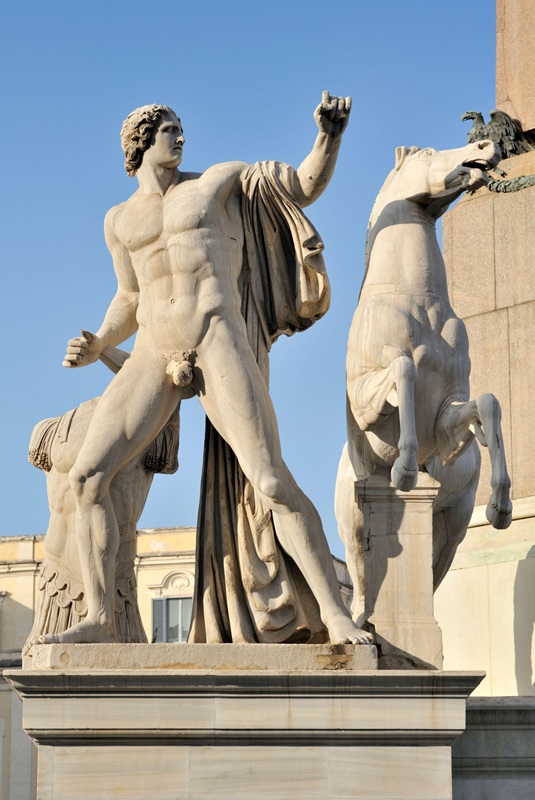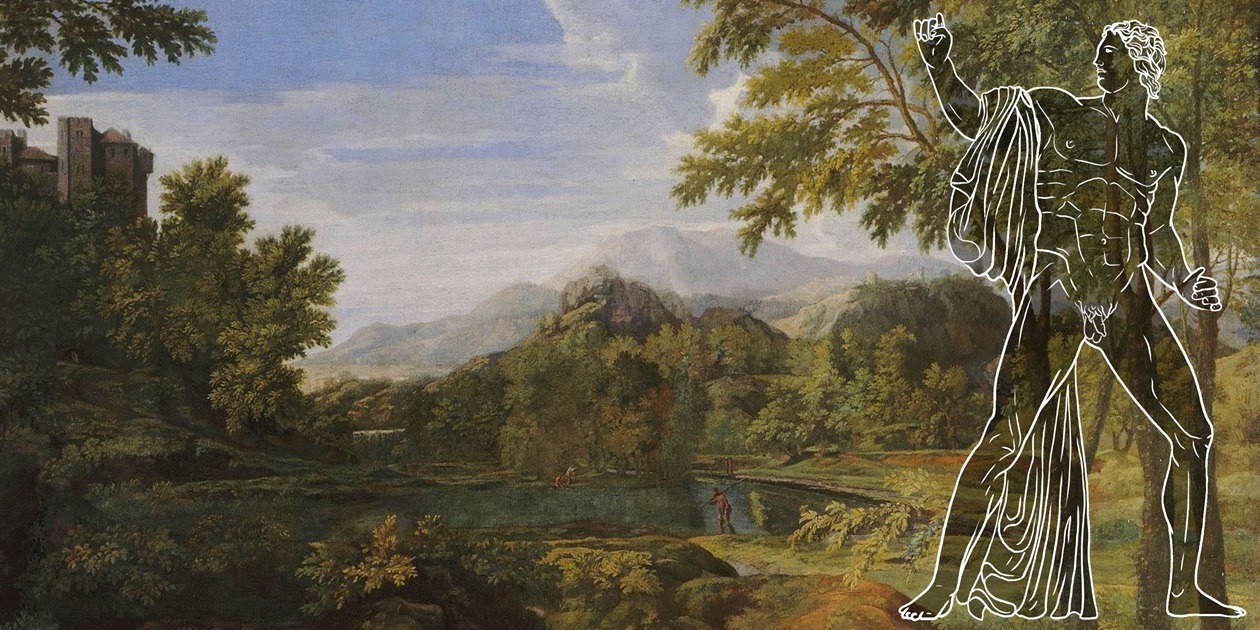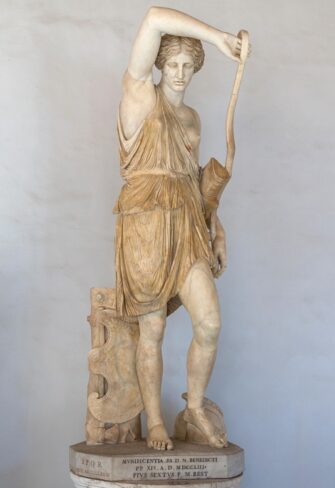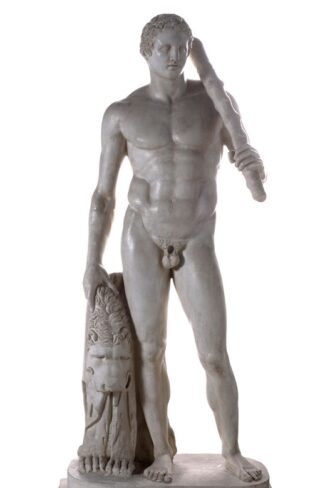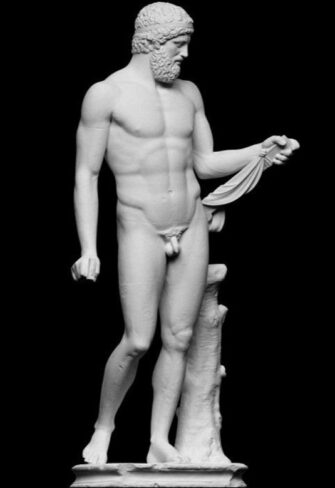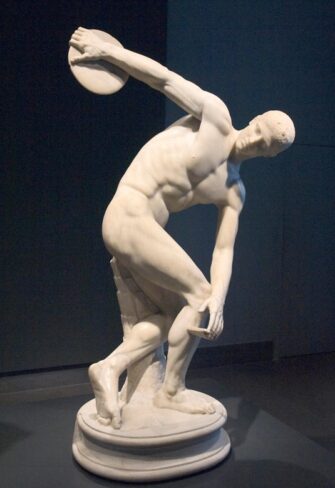All Products
Dioscuri Statue Quirinal
Please contact us for a quotation
incl. VAT plus Shipping Costs
Delivery time: 12 weeks. Deliveries to Scotland: 13 weeks. Free delivery in England, Scotland & Wales (except islands)
Origin and location of the original statue for the bronze replica
The Dioscuri Fountain on the Roman Piazza del Quirinale is flanked by the 5.6 metre high statues of the Dioscuri Castor and Pollux. Placed in front of an obelisk, they hold two rearing steeds in check. The left horse tamer of the collosal statue group is depicted. Both ancient statues were recovered from the ruins of the Baths of Constantine before 1585. They were erected in Quirinal Square under Pope Sixtus V. They are Roman copies of Greek originals made of bronze, attributed to the sculptors Phidias and Praxiteles.
The young, muscular naked Dioskure, almost 6 metres tall in the original, reins an equally tall, leaping steed. The sheer size of the statue group makes it a truly monumental sight. The bent right arm has its hand clenched into a fist at thigh height. The Dioskure is standing on the right leg, which is slightly bent and pointing outwards. The torso of a warrior, whose head is missing, is visible behind the foot and supporting leg. The upper body is unclothed, the leg dress of the torso is held by a double-breasted belt. The Dioskure himself is looking to the left, highly focussed. His head is covered by a thick head of curly hair. The robe, which falls to the ground, is thrown loosely over his upper arm. With his left hand raised, he is taming the horse, which is leaping away to the left, with (lost) bronze reins. This mighty bronze replica, which you can buy in our online shop, is made from the plaster cast of the original statue, which was produced in Rome in 1799. Please note when purchasing that later additions, in particular the left forearm, are missing here.
Description
Who are the Dioscuri of the Quirinal?
Most modern scholars agree that the two Dioscuri Castor and Pollux, or Polydeukos in Greek, are depicted here. Polydeukes is the son of Leda and Zeus, who seduced her in the form of a swan.
Castor is the son of Leda and her husband Tyndareos. Conceived on the same night, the twins are inseparable. Polydeuces, a pugilist, is immortal as the son of a god, but Castor, a horse tamer, is a mortal.
Historical significance, trivia
Horses and Dioscuri were once part of the ancient monumental Temple of Serapis, located on today’s Piazza del Quirinale and in the immediate neighbourhood of the Baths of Constantine. Other famous statues were recovered in this neighbourhood. Two statues of Constantine, one of which is located in the Lateran Basilica. The other statue of Constantine is located on the balustrade of the Capitoline Square. Another statue depicting Constantine’s son, Constantine II, as Caesar is also located on the Capitol Square. Two statues representing the Nile and Tiber adorn the fountains at the Palazzo Senatorio.
In 1942, Mussolini decorated his Palazzo della Civiltà italiana in Rome’s EUR district with four monumental equestrian statues by Publio Morbiducci and Alberto de Felci depicting the Dioscuri.
Antique statue, bronze replica in museum quality
The sculpture is produced as a bronze cast using the traditional lost wax technique. The negative mould required for this is based on a plaster cast of the original made in Rome in 1799. The finished bronze sculpture is of museum quality and corresponds to the original in Rome as it was in 1799. Later additions and restorations, in particular the left forearm, are missing here.
Cast marble & marble sculpture from the sculptor
In addition to classic bronze casting, we also offer two other moulds for the statues shown here. Marble casting from powdered genuine white marble. And the new moulding of the statue by sculptors from a single block of white marble. If you are interested in such a mould, please do not hesitate to contact us. We look forward to receiving your e-mail or phone call.
Patinating the bronze replica statue
Patination marks the final step in the finishing process of a bronze statue. The patina simulates the natural oxidation process that causes the bronze to weather differently over time, depending on the environmental influences on the copper alloy. We have various patina recipes in our repertoire, including one that corresponds well to the patina of preserved antique bronze statues. If you are interested in purchasing a patina, we will be happy to provide you with samples in advance.
Individualisation of the statue
Each replica statue cast by us is engraved in the base with a serial number, date of manufacture and our company logo. The base is also engraved with your name, a lettering, the occasion of the production, your own company logo or additional details as required. Simply let us know the details when you purchase the bronze replica statue.
Your very personal legacy
Our life-size cast bronze replicas are therefore not only artistic replicas, but also timeless reminders that will preserve your legacy for generations to come. By engraving your name, the date and the occasion on the base, this statue becomes an everlasting symbol of your most personal life achievement, your significance in this world and your work there.
Memory cast in bronze in the radiant light of antiquity
Ancient Greek bronze statues and their masterfully crafted Roman marble replicas were the sensual and visual mirror of these two cultures for over a millennium.
advanced civilisations. After their rediscovery during the Renaissance, these statues once again became world-famous and symbolised the emergence of modernity.
In keeping with the ancient traditions of Delphi and Rome, the statue made for you and with your name as the donor will forever be a reminder of your personality and achievements.
Locations for the installation of ancient statues & list of parks with ancient sculptures
Antique statues are hardly available in the original. Since their rediscovery in the Renaissance, expensive replicas have been made for castles, their parks and also for the mansions of the wealthy bourgeoisie. During this period, a canon for the installation and placement of these works of art was created that developed into modern times. Here you will find an overview of particularly beautiful locations for antique statues. We also offer you an overview of some publicly accessible gardens and parks, each of which has an impressive collection of ancient sculptures. With specific details of which statues can be seen where. Go travelling, let yourself be inspired!
Locations for the Placement of Ancient Statues
In exceptionally designed gardens and parks, alongside high horticultural artistry and exceptionally beautiful design, the use of top-notch furnishings often shines. Whether it’s furniture or statues and sculptures. Now original antique statues are not or very rarely available for sale. Since their rediscovery in the Renaissance, costly replicas have such been made for castles, their parks, and concurrently for the mansions of the bourgeoisie who have attained great wealth. During this time, a canon for the placement and positioning of these artworks formed and developed into modern times. In our online shop, you’ll find an overview of particularly beautiful locations for ancient statues. Additionally, we provide you with an overview of some publicly accessible gardens and parks, each boasting an impressive collection of ancient sculptures, along with specific details on where each statue can be seen.
Product details
| Item No. | S06 |
|---|---|
| Material | Bronze cast |
| height | 560 cm |
| What you receive | Single piece, Bronze cast. The exact design details, measurements and weight as well as the structure and colour of the Bronze cast may vary. |
| Delivery | Delivered using our own van |
| Delivery Charge | Free delivery in England and Wales (except islands) and to a few EU countries. Click here for details. |
| Price incl. VAT | |
